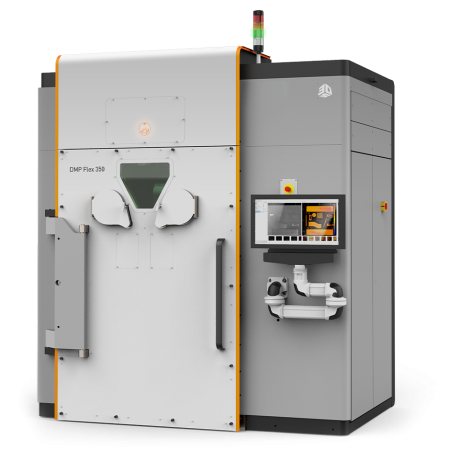MolyWorks Materials Corporation (Molyworks) partnered with 3D Systems to help meet growing demand from its consistent growth. The company purchased 3D Systems’ Direct Metal Printing (DMP) solution to enhance its in-house additive manufacturing (AM) production capabilities while broadening its customer offering.
With a larger print volume and unique vacuum chamber functionality, the 3D Systems’ DMP Flex 350 solution has increased MolyWorks agility and efficiency. These dynamic improvements have bolstered their expanding relationships commercial customers and government agencies, including their most recent engagement with United States Air Force.
For rapid design or product iteration, the 3D Systems’ DMP Flex 350 is unmatched. By having this industry-leading solution in our facility, we’re expanding our vision of what can be 3D printed in our processes.—Chris Eonta, MolyWorks founder and executive
WATCH: MolyWorks Improves Air-Worthy Aerospace Part Production Capabilities
MolyWorks, a California-based, developer of the circular economy for metal, has integrated the DMP Flex 350, and 3DXpert into its manufacturing workflow. As a result, MolyWorks has recognized significant efficiency improvements in its production process, and opportunities to enhance the breadth of capabilities by delivering additively manufactured end-use parts to its customers.
The Challenge
Streamline production and expand customer offering potential
Aerospace and defense OEMs are constantly looking to optimize their systems through the creation of cutting-edge components that can improve performance through design optimization. With its unique technology that is able to recycle metal from existing waste streams, MolyWorks has already produced 21 alloys for land, air, sea, and space applications.
To meet its customers' ever-increasing needs in the highly-regulated aerospace market, MolyWorks sought out 3D Systems’ Application Innovation Group to expand and refine their in-house metal AM production capabilities.
DMP is an AM technology that uses thin layers of metal powder melted by high-powered lasers to build high quality, complex metal parts from 3D CAD data. DMP provides exceptional design flexibility and isn’t hindered by the geometry limitations of traditional manufacturing. With DMP, manufacturing costs for parts are much less dependent on part complexity. This can also help alleviate supply chain hurdles by abridging the post-processing chain.
The Solution
Refined Titanium Production
To fit into its workflow as a producer of metal powder for quality parts, MolyWorks needed an AM solution that was able to hold a very low oxygen levels. This helps maintain alloy chemistry in the finished parts.
MolyWorks chose the 3D Systems’ DMP Flex 350 due to its unique vacuum chamber architecture, which can easily maintain very low partial pressures of oxygen (>25 ppm). This is especially critical for titanium alloy components which have tight oxygen tolerances to control mechanical properties. In addition to maintaining a very low oxygen manufacturing environment, the vacuum chamber architecture also reduces argon consumption and produces an excellent surface finish with fine feature detail.
“With its unique vacuum chamber, we’re able to get our process down to five parts per million oxygen within the chamber. The DMP Flex 350 performs in a different class than competitive machines by delivering better chemistry control in finished parts and high levels of powder reuse,” according to Devin Morrow, MolyWorks Director of AM.
Greater Application Flexibility and Speed
Prior to implementing the 3D Systems solution, MolyWorks’ was limited by a smaller 3D printing system.
With the 3D Systems DMP Flex 350, MolyWorks can facilitate rapid design and product iterations and production of consolidated components. The removable print module (RPM) on the 3D Systems printer — which minimizes downtime for cleaning and material swaps — has accelerated MolyWorks production and certification process, and shortened development cycles.
“Having the DMP 350 allows us to do the prototyping at a larger scale and much quicker,” said Morrow. “If we are switching over to a new alloy, we don’t want it to take weeks to get back online. With these machines in-house, we can print 9 different iterations of the same part and rotate them out quickly.”
Streamlined Design to Production
DMP is ideal for producing compact components with complex or irregular shapes, internal channels, complex surface textures and internal lattices.
3DXpert operates on solid models, directly from a routine engineering design process. There is no need to deal with intermediate, problematic, STL files. Directly 3D printing a part from a CAD file dramatically cuts the time from concept, to design, to manufactured part without losing feature fidelity. The 3D Systems DMP Flex 350 with Oqton’s 3DXpert software supports every step of the AM workflow—from design through build preparation and modeling.
Using 3DXpert, MolyWorks engineers can support structure generation, lattice design and generative design all within the same interface. This single software solution provides the ability to mix and match some of those strategies within the same part and save it in one place, eliminating the need for multiple software packages.
“Being able to seamlessly transition from design and optimization in 3DXpert to production with the DMP Flex 350 has really helped us streamline our process,” said Morrow.
Larger Scale Manufacturing
The DMP Flex 350 has one of the largest build volumes available in a mid-frame LPBF (Laser Power Bed Fusion) system (275mm x 275mm x 420mm). This larger build volume, which surpasses the size of most competing systems, allows complete flexibility. In addition to printing large components, the space can be used to print multiple smaller components or consolidate components into larger, more efficient unitized assemblies.
This expanded in-house production capability has helped MolyWorks expand its business, including engagements with five U.S. government agencies and cornerstone commercial customers in each of its major segments: healthcare, automotive, aerospace, defense, oil and gas and energy.
“With the 3D Systems unit, we went from doing one or two components to doing full builds with 10+ components on a build,” said Eonta. “We’re very impressed by the quality of the landing gear components we’re producing with this printer that will be tested for airworthiness, and we are looking forward to the additional applications we will address.”
